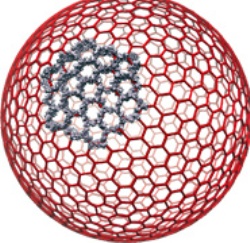Apr 16 2013
Scientists have developed a new type of nanoparticle with potential applications in chemistry, biology and medicine. The findings, published in Science and led by a multidisciplinary team of researchers from the University of Bristol, could potentially be used to deliver bioactive molecules, such as drugs, to cells and eventually diseased tissues in the body.
 Nanoscale cages called SAGEs. Image by Richard Sessions, Thom Sharp and Jordan Fletcher
Nanoscale cages called SAGEs. Image by Richard Sessions, Thom Sharp and Jordan Fletcher
The research, led by Professor Dek Woolfson from the University’s Schools of Chemistry and Biochemistry, describes how small protein molecules, known as peptides, can be designed from scratch to deliver a toolkit for constructing more-complex structures and materials. This is part of an emerging global effort to engineer biological systems more predictably and reliably, known as synthetic biology.
In the new work, the Bristol team has used parts from the toolkit to make larger hexagonal protein assemblies, which then piece themselves together to make protein sheets, resembling the pattern of hexagons in chicken wire. Curiously, the protein sheets then fold over on themselves and close to form hollow spheres (see image).
These spheres are 100 nm across — which equates to about one hundredth the width of a human hair — they are just one sheet of molecules thick, and they have nanometer-sized openings on their surfaces. They are in fact nanoscale cages, which the team call SAGEs. These have a number of potential practical applications. For instance, the team will be pursuing ideas such as using the SAGEs as the basis for new vaccines; to deliver bioactive molecules, such as drugs, to cells and eventually diseased tissues in the body; and to concentrate enzyme molecules to perform chemical reactions more efficiently and controllably.
Professor Woolfson said: “We are extremely excited by this new work. First of all, it has been fun bringing a really talented team from across the University together to do the research. Also, we are really looking forward to developing potential applications of the SAGEs. For this, we are going to grow the team and explore new areas in medicine and synthetic biology. It’s going to be challenging to do this, but extremely interesting and hopefully rewarding.”
Much of the work has been done by Dr Jordan Fletcher, a post-doctoral researcher in Prof Woolfson’s lab.
The project has involved a multidisciplinary team of researchers from across the University. For example, images of the SAGEs using Scanning Electron Microscopy were collected by Dr Paul Verkade and Judith Mantell from the School of Biochemistry, while the hexagonal surface structure has been observed using advanced atomic force microscopy methods developed by Dr Rob Harniman, Dr Massimo Antognozzi and Professor Merv Miles from the School of Physics. Finally, the entire process of assembly and folding of the SAGEs has been modelled using computers by Dr Richard Sessions from the School of Biochemistry and Prof Noah Linden from the School of Mathematics.
The work has been funded by the BBSRC through a grant to Professor Dek Woolfson and Professor Paula Booth from the School of Biochemistry.